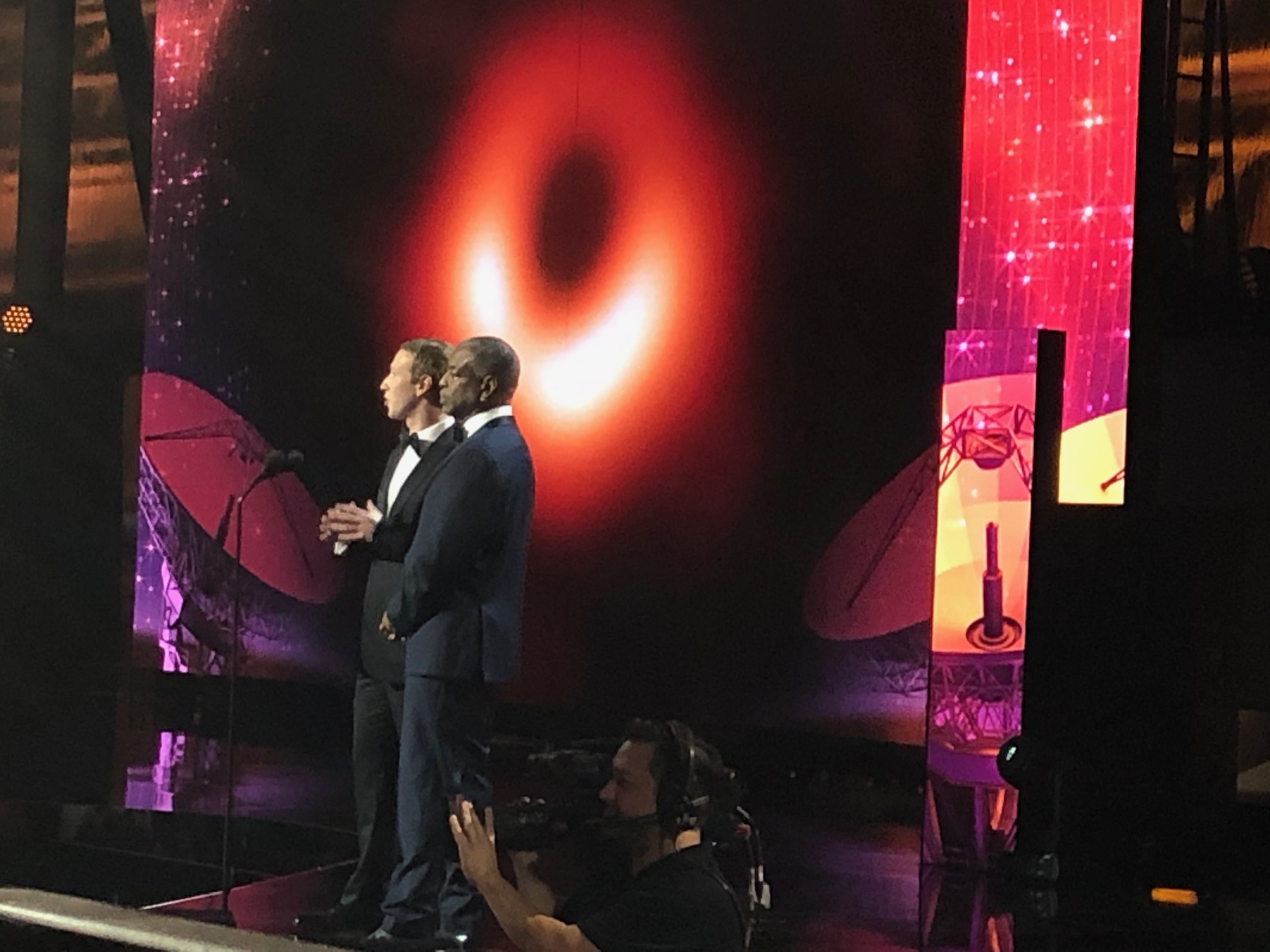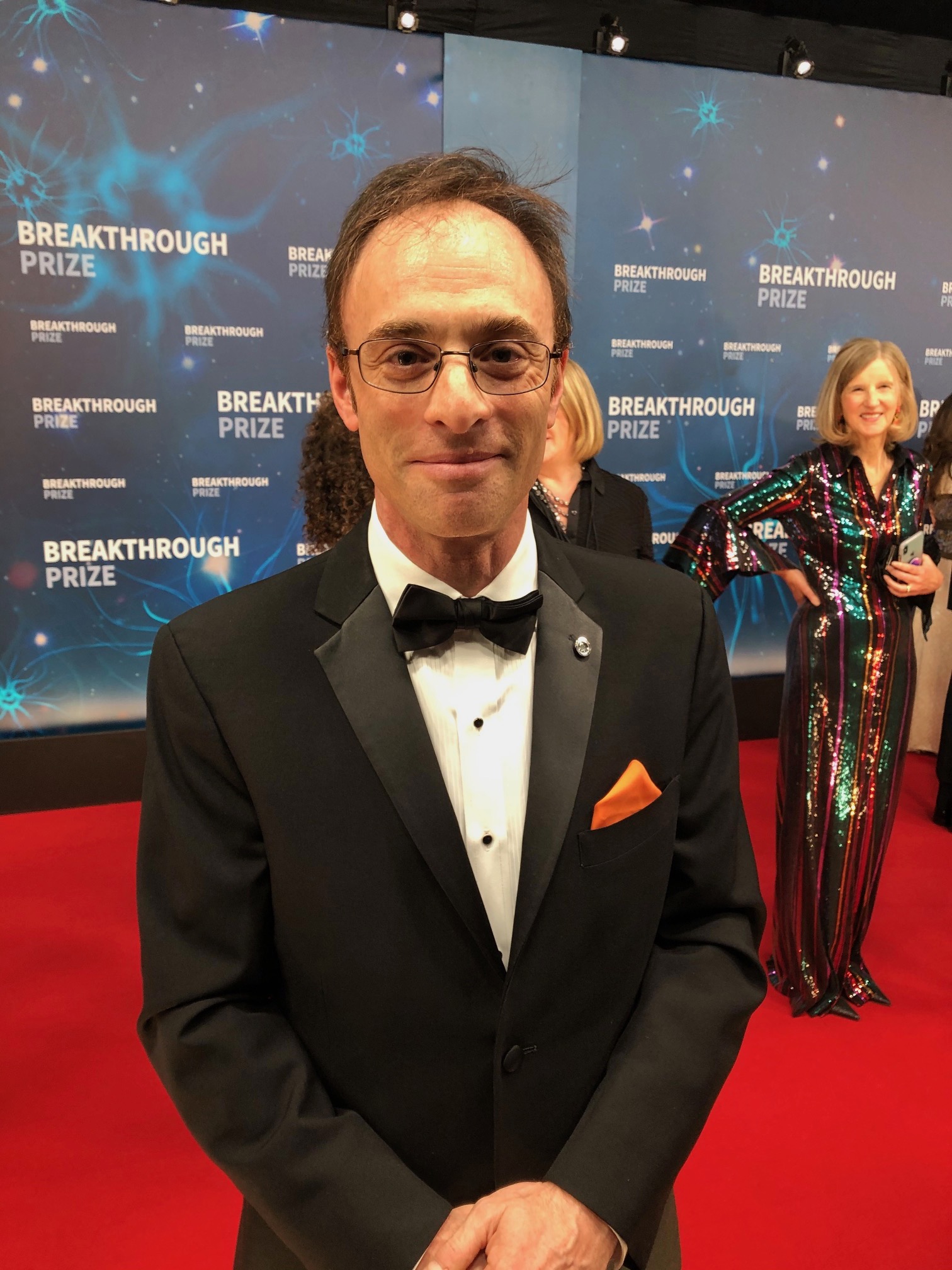
MOUNTAIN VIEW, Calif. — The “Oscars of Science” had a very space-y feel.
The theme of the ceremony for the eighth annual Breakthrough Prize, which was held last night (Nov. 3) here at NASA’s Ames Research Center, was "Seeing the Invisible," a nod to the Event Horizon Telescope (EHT) project.
In April, EHT team members announced a landmark discovery: They had captured an image of the supermassive black hole at the heart of the galaxy M87, which lies about 55 million light-years from Earth. Specifically, they had photographed the M87 behemoth's event horizon, the point of no return beyond which nothing, not even light, can escape. (Photographing the interior of a black hole is impossible, unless you're in there yourself, which would not be fun.)
Related: Historic First Images of a Black Hole Show Einstein Was Right (Again)
The EHT scientists — all 347 of them — shared the $3 million Breakthrough Prize in Fundamental Physics this year, we learned in September. Project leader Shep Doeleman, of the Harvard-Smithsonian Center for Astrophysics, accepted the award during last night's ceremony, which aired on The National Geographic Channel and YouTube.
"It's a great honor to accept this award on behalf of our wonderful international collaboration," Doeleman said in his acceptance speech. "When we saw the first image of a black hole, our team experienced a range of emotions. But mostly we felt alive, because that moment of discovery is what it means to be human."
The Breakthrough Prize doles out the richest awards in science, which are worth about three times more than the Nobel Prize. Doeleman wasn't alone in raking in hardware: Four annual Breakthrough Prizes in life sciences and one in mathematics were given out last night, as was one special award in fundamental physics.
Get the Space.com Newsletter
Breaking space news, the latest updates on rocket launches, skywatching events and more!
This latter distinction went to Sergio Ferrara, Daniel Freedman and Peter van Nieuwenhuizen for their development of the theory of supergravity, which has the potential to meld gravity with quantum mechanics.
All three of the supergravity pioneers said a few words. Van Nieuwenhuizen's disarmed the well-dressed crowd, which included tech titans such as Facebook CEO Mark Zuckerberg and Google co-founder Sergey Brin, along with celebrity entertainers like Tyra Banks and event emcee James Corden.
"When I heard I had won the prize, I was sitting at the kitchen table paying a dental bill," the 81-year-old van Nieuwenhuizen said. "And my wife said to me, 'Now you can buy a whole new set of teeth.'"
Others joined the EHT and supergravity researchers in repping the space community here last night. For example, Virgin Galactic CEO George Whitesides and former NASA science chief John Grunsfeld were in attendance. Canadian astronaut Chris Hadfield walked the red carpet before the ceremony, and NASA Administrator Jim Bridenstine contributed a five-paragraph intro to the event's official program.
"I send my greetings to all those attending the Breakthrough Prize ceremony at NASA's Ames Research Center in Mountain View, California," wrote Bridenstine, who wasn't there in person. "All of us at NASA are delighted to assist in honoring those whose vision and determination have led to scientific and technological advancements."
Related: Can NASA Really Land Two Astronauts on the Moon in 2024?

The Breakthrough Prizes, and the ceremony that celebrates them every year, aim to help elevate scientists to the rarefied air that singers, actors and athletes enjoy in our society. If all goes according to plan, young people will eventually hold Doeleman, van Nieuwenhuizen and their ilk in the same emulatory esteem that they hold LeBron James, Corden and other entertainers today.
Hadfield is on board with this mission, stressing that he prioritizes sharing his spaceflight experiences, especially with kids.
"I've resolved not to keep it to myself," Hadfield told Space.com on the red carpet before last night's ceremony. "To me, it's an important part of not squandering the work that we've done."
Doeleman voiced similar sentiments.
"This doesn't belong to us; it belongs to all of humanity," he told Space.com, referring to the epic EHT imagery. "We need people to be curious. We need people to wonder."
Some of the celebrities who participated in last night's ceremony had some space-adjacent bona fides as well. The award presenters included LeVar Burton, who played Geordi La Forge on "Star Trek: The Next Generation," and Taraji P. Henson, who portrayed NASA mathematician Katherine Johnson in the acclaimed 2016 film "Hidden Figures." (Burton and Zuckerberg presented the EHT team's award.)
On the red carpet, Henson said that she herself isn't mathematically or scientifically inclined. But "Hidden Figures" got her in the Breakthrough Prize door.
"It was so important that Silicon Valley invited me here," she said with a laugh.
The Breakthrough Prize in science and math was founded in 2012 by Mark Zuckerberg and Priscilla Chan, Sergey Brin, Anne Wojcicki, and Yuri and Julia Milner.
The Breakthrough Prize also recognizes early-career researchers with $100,000 "New Horizons" awards. Six such awards were given out this year, three each in physics and mathematics. And 17-year-old high school student Jeffery Chen won the fifth annual Breakthrough Junior Challenge for his video about neutrinos. You can learn more about the organization and the prizes here: https://breakthroughprize.org/
- Black Hole Photos Could Get Even Clearer with Space-Based Telescopes
- The Future of Black Hole Photography: What's Next for the Event Horizon Telescope
- The Universe: Big Bang to Now in 10 Easy Steps
Mike Wall's book about the search for alien life, "Out There" (Grand Central Publishing, 2018; illustrated by Karl Tate), is out now. Follow him on Twitter @michaeldwall. Follow us on Twitter @Spacedotcom or Facebook.
Join our Space Forums to keep talking space on the latest missions, night sky and more! And if you have a news tip, correction or comment, let us know at: community@space.com.

Michael Wall is a Senior Space Writer with Space.com and joined the team in 2010. He primarily covers exoplanets, spaceflight and military space, but has been known to dabble in the space art beat. His book about the search for alien life, "Out There," was published on Nov. 13, 2018. Before becoming a science writer, Michael worked as a herpetologist and wildlife biologist. He has a Ph.D. in evolutionary biology from the University of Sydney, Australia, a bachelor's degree from the University of Arizona, and a graduate certificate in science writing from the University of California, Santa Cruz. To find out what his latest project is, you can follow Michael on Twitter.









